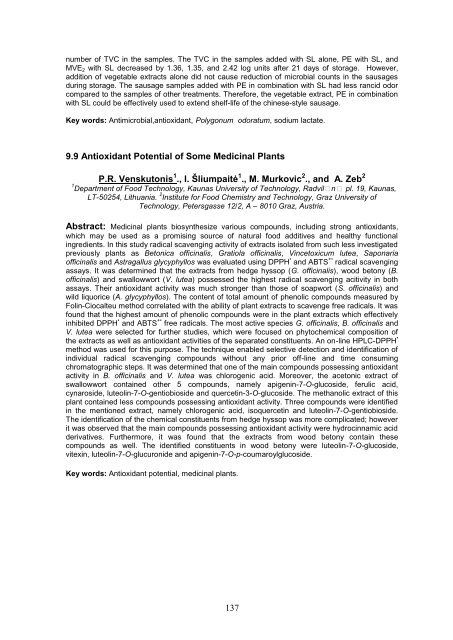Abstract Book - 3rd International Symposium on Medicinal Plants ...
Abstract Book - 3rd International Symposium on Medicinal Plants ...
Abstract Book - 3rd International Symposium on Medicinal Plants ...
Create successful ePaper yourself
Turn your PDF publications into a flip-book with our unique Google optimized e-Paper software.
number of TVC in the samples. The TVC in the samples added with SL al<strong>on</strong>e, PE with SL, and<br />
MVE 2 with SL decreased by 1.36, 1.35, and 2.42 log units after 21 days of storage. However,<br />
additi<strong>on</strong> of vegetable extracts al<strong>on</strong>e did not cause reducti<strong>on</strong> of microbial counts in the sausages<br />
during storage. The sausage samples added with PE in combinati<strong>on</strong> with SL had less rancid odor<br />
compared to the samples of other treatments. Therefore, the vegetable extract, PE in combinati<strong>on</strong><br />
with SL could be effectively used to extend shelf-life of the chinese-style sausage.<br />
Key words: Antimicrobial,antioxidant, Polyg<strong>on</strong>um odoratum, sodium lactate.<br />
9.9 Antioxidant Potential of Some <strong>Medicinal</strong> <strong>Plants</strong><br />
P.R. Venskut<strong>on</strong>is 1 ., I. Šliumpaitė 1 ., M. Murkovic 2 ., and A. Zeb 2<br />
1 Department of Food Technology, Kaunas University of Technology, Radvilın ı pl. 19, Kaunas,<br />
LT-50254, Lithuania. 2 Institute for Food Chemistry and Technology, Graz University of<br />
Technology, Petersgasse 12/2, A – 8010 Graz, Austria.<br />
<str<strong>on</strong>g>Abstract</str<strong>on</strong>g>: <strong>Medicinal</strong> plants biosynthesize various compounds, including str<strong>on</strong>g antioxidants,<br />
which may be used as a promising source of natural food additives and healthy functi<strong>on</strong>al<br />
ingredients. In this study radical scavenging activity of extracts isolated from such less investigated<br />
previously plants as Bet<strong>on</strong>ica officinalis, Gratiola officinalis, Vincetoxicum lutea, Sap<strong>on</strong>aria<br />
officinalis and Astragallus glycyphyllos was evaluated using DPPH • and ABTS +• radical scavenging<br />
assays. It was determined that the extracts from hedge hyssop (G. officinalis), wood bet<strong>on</strong>y (B.<br />
officinalis) and swallowwort (V. lutea) possessed the highest radical scavenging acitivity in both<br />
assays. Their antioxidant activity was much str<strong>on</strong>ger than those of soapwort (S. officinalis) and<br />
wild liquorice (A. glycyphyllos). The c<strong>on</strong>tent of total amount of phenolic compounds measured by<br />
Folin-Ciocalteu method correlated with the ability of plant extracts to scavenge free radicals. It was<br />
found that the highest amount of phenolic compounds were in the plant extracts which effectively<br />
inhibited DPPH • and ABTS +• free radicals. The most active species G. officinalis, B. officinalis and<br />
V. lutea were selected for further studies, which were focused <strong>on</strong> phytochemical compositi<strong>on</strong> of<br />
the extracts as well as antioxidant activities of the separated c<strong>on</strong>stituents. An <strong>on</strong>-line HPLC-DPPH •<br />
method was used for this purpose. The technique enabled selective detecti<strong>on</strong> and identificati<strong>on</strong> of<br />
individual radical scavenging compounds without any prior off-line and time c<strong>on</strong>suming<br />
chromatographic steps. It was determined that <strong>on</strong>e of the main compounds possessing antioxidant<br />
activity in B. officinalis and V. lutea was chlorogenic acid. Moreover, the acet<strong>on</strong>ic extract of<br />
swallowwort c<strong>on</strong>tained other 5 compounds, namely apigenin-7-O-glucoside, ferulic acid,<br />
cynaroside, luteolin-7-O-gentiobioside and quercetin-3-O-glucoside. The methanolic extract of this<br />
plant c<strong>on</strong>tained less compounds possessing antioxidant activity. Three compounds were identified<br />
in the menti<strong>on</strong>ed extract, namely chlorogenic acid, isoquercetin and luteolin-7-O-gentiobioside.<br />
The identificati<strong>on</strong> of the chemical c<strong>on</strong>stituents from hedge hyssop was more complicated; however<br />
it was observed that the main compounds possessing antioxidant activity were hydrocinnamic acid<br />
derivatives. Furthermore, it was found that the extracts from wood bet<strong>on</strong>y c<strong>on</strong>tain these<br />
compounds as well. The identified c<strong>on</strong>stituents in wood bet<strong>on</strong>y were luteolin-7-O-glucoside,<br />
vitexin, luteolin-7-O-glucur<strong>on</strong>ide and apigenin-7-O-p-coumaroylglucoside.<br />
Key words: Antioxidant potential, medicinal plants.<br />
137

















